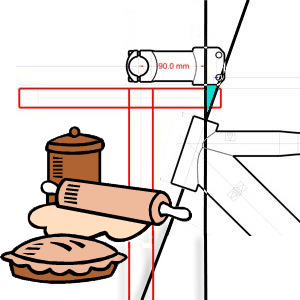Adjust your Exit bike

Here's your warning: We've probably never published an article less appealing to the masses. But nobody accuses us of publishing softcore only, and this is why you read us, right? So…
If you're a bike fitter and you own the state-of-the-art fit bike for tri bike positioning, here's the latest. We're adjusting our Exit bikes and you should too. Hang with me here, this is a little bit technical.
The point of the adjustment is this: As you know, there are two "pistons" that allow the front of this fit bike, where the aerobars are mounted, to adjust up and down. This allows the rider and fitter to determine whether the aerobars should be positioned higher or lower. You read the "stack" measure from the off-side piston (as opposed to the drive-side piston). Only the off-side piston has the laser etching that tells you what the stack measure is.
When you read "stack" off this piston, it tells you what the the stack is to the top of that black plate along which the aerobars slide fore and aft. As you'll note, however, there is an "angled wedge" that allows us to sit the aerobars back at 72.5° or so of head angle. This angled wedge is important, because it relieves us of having to do any trigonometry to account for "negative reach," that is, how much reach is lost when more and more spacers are placed under the stem.
This angled wedge was added last year as a running change to the Exit bike. However, this wedge added about 10mm of space between the stem and the black plate, and we've had to account for that. Up 'til now, we've just been saying that this wedge is a proxy for the headset top cap.
Well, that's fairly imprecise, isn't it? Some companies have 5mm top caps (Trek), others 20mm (lots of companies use that).

So, we're going to remedy this, and our remedy is to raise the top of that off-side piston 10mm above the black plate. This now means that the "stack" measure that you read on the piston (the stack reads about 512mm in the pic just adjacent) is now the stack at the top of the angled wedge, instead of at the bottom of the angled wedge.
Further, when we read the "reach" we're now reading the reach down the vertical line etched into the angled wedge by the factory, instead of scratching in our own angled line, as we did in the pic above (you can see our own scratched-in angled line if you look closely). Note in the pic adjacent there is only one line etched, and that vertical line is the one that comes from the factory. After you execute this "fix," that's the only line you'll read.
How do you do this to your existing Exit bike? First, realize you only need to move the piston up on the off side. The drive side piston has no etching, so, just leave it alone, unless you're compulsive and you have to have perfect symmetry in everything.
This is easy to do, but, you must think about what you're doing. All you need is a rubber mallet, and the right Allen wrench. Just know that Ves Mandaric—the maker of the Exit bike—purposely chose to use an imperial Allen so that you guys wouldn't touch this bolt. Well, now I'm telling you to touch it, so, get out your set of imperial Allens, or go down to Harbor Freight Tool and get yourself a cheap set (Computrainer uses imperial as well, so, I guess it makes sense to have a set of these around).
Step 1: Raise the black plate up several centimeters above its bottom height, and this will of course force the pistons several cms up out of the supports.
Step 2: Lock the quick release down on the off side, to keep the front end of the bike suspended at that level.
Step 3: Loosen the quick release on the drive side. Make sure you do this! Otherwise, when you start hitting the black plate with a rubber mallet, nothing's going to happen.
Step 4: Loosen the tightening bolt on the off side. NOT on the drive side.
Step 5: Lightly tap the black plate with a rubber mallet. You'll see the off-side piston start to stick up above the black plate. Tap until 10mm worth of piston sticks up above the black plate.
Step 6: Tighten the bolt that affixes the black plate to the off side piston. You're done.
What this means in real life: Now, you have to account for everything that sticks up above a bike's head tube top, including the headset top cap. The stack you read on the etched piston is now the vertical measure from the BB to the top of the angled wedge.
For example, in the first pic, highest above, you'll note that there are 5 x 5mm spacers under the stem. This is to replicate a bike with a 20mm headset top cap, and 10mm of spacers, because this fit bike has been set up to accommodate a customer who thinks he's interested in purchasing a bike that comes, standard, with a 20mm top cap. The fitter added another 10mm of spacers, so that the end product of the fit process would be the right-sized bike, in that model, with 10mm of spacers to spare.






Start the discussion at forum.slowtwitch.com